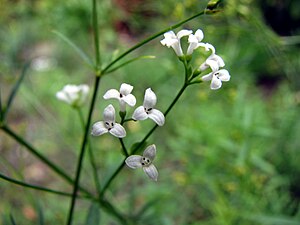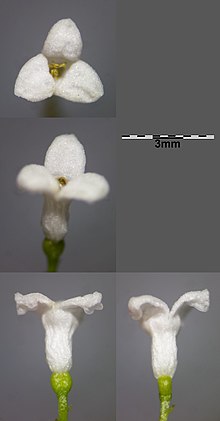Färber-Meier
| Färber-Meier | ||||||||||||
|---|---|---|---|---|---|---|---|---|---|---|---|---|

Färber-Meier ( Asperula tinctoria ) |
||||||||||||
| Systematics | ||||||||||||
|
||||||||||||
| Scientific name | ||||||||||||
| Asperula tinctoria | ||||||||||||
| L. |
The Färber Meier ( Asperula tinctoria ) is a species of the red family (Rubiaceae) native to Central Europe . The species was used as a coloring plant , roots and rhizome were used for yellowing.
features
The Färber-Meier is a perennial herbaceous plant and reaches heights of 30 to 70 cm. It forms subterranean runners. The stems are square, mostly single and upright. The leaves are in whorls of six at the bottom and four at the top. The bracts have no spike tip.
The crown is white and usually has three columns. The outside is smooth. The corolla tube is once or twice as long as the corolla lobes. Flowering time is June and July, pollination is carried out by insects .
The fruits are dry. They do not have hooked hair and are straight or wrinkled.
The chromosome number is 2n = 22 or 44.
Distribution and locations
The Färber-Meier is a submeridional-temperate species and occurs in Europe in continental levels 2 to 5. Its distribution area extends from Europe to western Siberia. In Germany the species has declined sharply, in Saxony and Lower Saxony it is extinct. In Austria it is largely classified as endangered.
The Färber-Meier grows in dry forests, on the edges of dry bushes, in semi-dry lawns and on rocky slopes. It usually grows on calcareous soils. It occurs from the colline to the montane elevation , up to 1000 m above sea level.
In terms of plant sociology, it is a type of the Erico-Pinion , Cytiso-Pinion or Geranion sanguinei associations in Central Europe .
Subspecies
Two subspecies can be distinguished:
- Asperula tinctoria subsp. hungarorum (Borbás) Soó : It occurs in the Czech Republic, Hungary and Romania.
- Asperula tinctoria subsp. tinctoria
Common names
In German-speaking countries, the other trivial names Wilde Bergröte and Wilde Färberöte are or were used for this plant species .
supporting documents
- Siegmund Seybold (Ed.): Schmeil-Fitschen interactive (CD-Rom), Quelle & Meyer, Wiebelsheim 2001/2002, ISBN 3-494-01327-6
Individual evidence
- ^ A b Manfred A. Fischer , Karl Oswald, Wolfgang Adler: Excursion flora for Austria, Liechtenstein and South Tyrol. 3rd, improved edition. State of Upper Austria, Biology Center of the Upper Austrian State Museums, Linz 2008, ISBN 978-3-85474-187-9 .
- ^ A b c Werner Rothmaler: Excursion flora from Germany. Volume 4. Vascular Plants: Critical Volume . 10th edition, Elsevier, Munich 2005, ISBN 3-8274-1496-2
- ↑ a b Erich Oberdorfer : Plant-sociological excursion flora for Germany and neighboring areas . With the collaboration of Angelika Schwabe and Theo Müller. 8th, heavily revised and expanded edition. Eugen Ulmer, Stuttgart (Hohenheim) 2001, ISBN 3-8001-3131-5 , pp. 762 .
- ↑ a b c Rafaël Govaerts (Ed.): Asperula tinctoria. In: World Checklist of Selected Plant Families (WCSP) - The Board of Trustees of the Royal Botanic Gardens, Kew . Retrieved January 27, 2016.
- ^ Georg August Pritzel , Carl Jessen : The German folk names of plants. New contribution to the German linguistic treasure. Philipp Cohen, Hannover 1882, page 48, online.
Web links
- Asperula tinctoria L., Färber-Meier. In: FloraWeb.de.
- Färber-Meier . In: BiolFlor, the database of biological-ecological characteristics of the flora of Germany.
- Asperula tinctoria L. In: Info Flora , the national data and information center for Swiss flora . Retrieved January 27, 2016.
- Distribution in the northern hemisphere according to: Eric Hultén , Magnus Fries: Atlas of North European vascular plants 1986, ISBN 3-87429-263-0
- Thomas Meyer: Master data sheet with identification key and photos at Flora-de: Flora von Deutschland (old name of the website: Flowers in Swabia )


